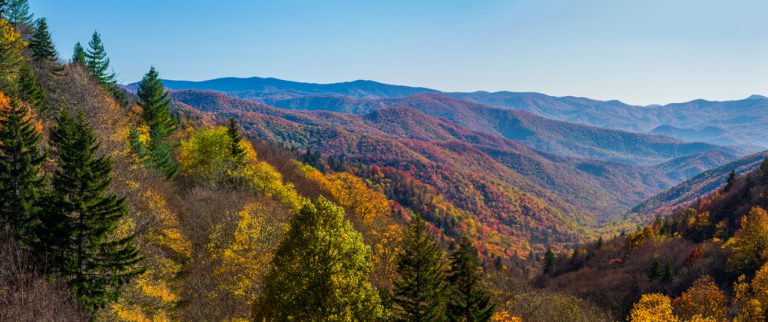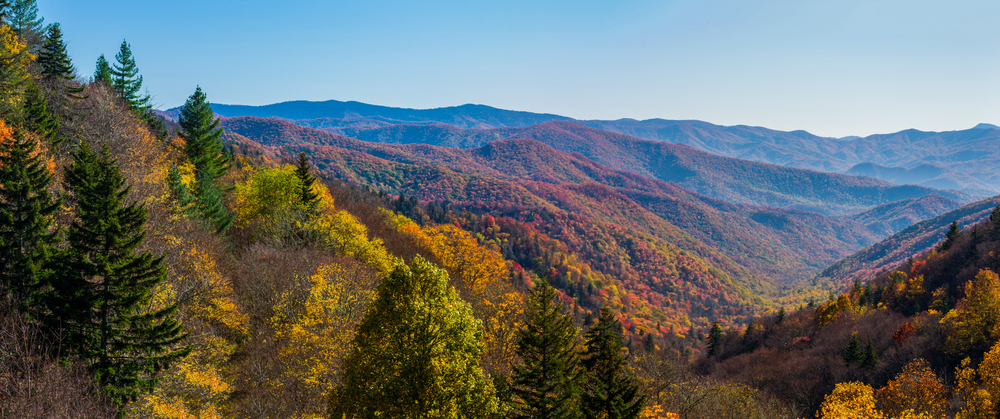
Covering a massive 522,427 acres straddling the state lines between North Carolina and Tennessee, there’s good reason that Great Smoky Mountains National Park is consistently among the most-visited national parks on the American roster. It’s relatively easily accessible to east coasters (who don’t have quite as many national parks to choose from as Americans who live out west), not to mention the fact that it’s drop-dead gorgeous.
Every year, millions of visitors flock to this special wilderness to hike, rock-climb, camp, mountain bike, and simply enjoy this one-of-a-kind natural preserve. But the Great Smoky Mountains have a ringing and often-overlooked human history that’s all too easy to forget about entirely. These mountains and their stunning valleys are the ancestral home of the Cherokee Indians, along with countless other Indigenous Peoples who have traveled on, inhabited, and stewarded this land since time immemorial.
The Indigenous History of Great Smoky Mountains National Park

White settlers first began arriving to the Great Smoky Mountains in the 1700s, whereupon they found themselves on Cherokee land. The Cherokees were one of the most advanced, developed, and established tribes in the Americas at the time, enjoying permanent settlements and cultivating their own agricultural food sources along with hunting and gathering local edible flora and fauna, situating themselves in the fertile river bottoms in order to do so. The Cherokees, who were a matriarchal society, also had a highly developed political structure and many important rituals, tribal meetings and ceremonies, as well as having established many of the trails that still criss-cross the park today.
However, the Cherokees had never before encountered white settler diseases, such as smallpox — which wiped out some 7,000 to 10,000 tribe members in the mid-1700s, or about half of the population. Those who remained by the early 1830s were forced to move to reservation land in Oklahoma by way of the tragic historic event today known as the Trail of Tears — whereupon thousands more Cherokees died.
Despite all this adversity, the Cherokee Nation is still going strong today, with many of their descendents still living in the areas close to the national park today. You can learn more about the Cherokee history of Great Smoky Mountain National Park on the official NPS website, as well as in interpretive signage and exhibits displayed in the park itself (such as at the visitor centers).
Paying Respect to the Land
Learning about the first peoples who inhabited a given landscape is an important step toward paying overall respect to the land and our small place in its history. As a visitor, it’s our obligation to ensure we leave a place as healthy as — or ideally, even better than, we found it.
The Native Americans and Indigenous Peoples who came before western settlers set an incredible precedent of stewardship and symbiosis with the land. They found ways to work with the Earth rather than against it — ways we’d be wise to continue to emulate and enact if we want to preserve these landscapes for future generations.
No matter where you are on American soil (and beyond), Native Land is an excellent resource for learning more about whose ancestral grounds you’re standing on. You can then go the extra mile by learning a little bit about their culture and story.
Additionally, Leave No Trace is an excellent organization that provides easy-to-follow principles that will help ensure your visit to any given wilderness remains low- or no-impact. For example, Leave No Trace principles involve packing out all the garbage you pack in (even biodegradables, like apple cores) as well as ensuring you don’t set a campfire in a place that hasn’t already had one, so as to avoid damaging more local plant life.
We hope these details give your visit to Great Smoky Mountains National Park that much nuance and context — and we hope you enjoy yourself while you visit this ancient, hallowed landscape.

